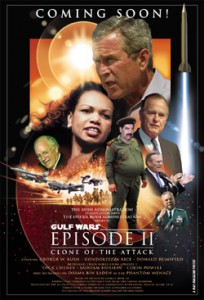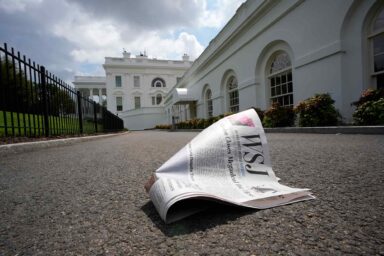If the past is not to be ignored, we have every reason to be skeptical of the justifications coming out of Washington for military action in Syria. Is it really about chemical weapons? Two words: Highly. Unlikely.
 Americans—and others—are in heated discussion these days over whether an attack on Syria might be justified by alleged use of chemical weapons. But no such discussion is complete without consideration of a long history of disinformation disseminated in order to drum up support for overseas wars.
Americans—and others—are in heated discussion these days over whether an attack on Syria might be justified by alleged use of chemical weapons. But no such discussion is complete without consideration of a long history of disinformation disseminated in order to drum up support for overseas wars.
To be sure, with the UN resolution giving Syria eight months to dump its chemical weapons, the calls in Washington for a military attack on Assad’s forces have been muted. But the Obama administration has reserved the right to attack if Syria misses that deadline—which, as we’ve reported, is absurdly short by standards with which the US itself says it could reasonably comply in eliminating its own chemical stocks.
The core point, however, is the rationale advanced for such an attack. It rests on the assumption that Syrian President Bashar al-Assad ordered the sarin gas bombardment of a Damascus suburb on August 21. But while there is no disagreement that chemical weapons were used that day, exactly who launched the attack is still very much an open question. For Washington to rush to judgment – and an act of war — on such an unsubstantiated charge suggests that more than righteous anger is at work here.
To understand what that might be, it pays to look deeper – both at the “evidence” linking Assad to the gassing and at the sobering history of America’s all-too-itchy trigger finger when it comes to justifying military strikes at perceived enemies, or when unstated geopolitical agendas and business interests may well be in play.
Whodunit?
The latest UN report on the August 21 bombing is widely cited by American officials as “proof” the Assad regime used chemical weapons. But the authors of that report deny that they proved anything about who is guilty of the atrocity. As they themselves state on the UN’s website:
“Responding to questions, the Secretary-General [of the UN] said Dr. Sellström’s team had been able to determine objectively that Sarin was used on a relatively large scale. It was the team’s job to determine whether and to what extent chemical weapons were used, not who used them.
“It is for others to decide whether to pursue this matter further to determine responsibility. We may all have our own thoughts on this, but I would simply say that this was a grave crime and those responsible must be brought to justice as soon as possible,” he said.
The Associated Press, the world’s largest news-gathering organization, finds no clear support for the administration’s claims about the Syrian government’s use of chemical weapons:
“What’s missing from the public record is direct proof, rather than circumstantial evidence, tying this to the regime.”
And in direct contradiction to the claims being made by American officials, German intelligence maintains the attacks were not ordered by President Assad. This conclusion was based on intercepts of the regime’s communications (Germany is a NATO member and a staunch US ally).
Alarmed by what they view as the dusting off of old methods they’ve seen time and again, , a group of dissident American ex-intelligence professionals wrote an open letter to President Obama expressing serious doubts as to whether the Assad regime was responsible for the recent chemical weapon attacks. They write:
“There is a growing body of evidence from numerous sources in the Middle East — mostly affiliated with the Syrian opposition and its supporters — providing a strong circumstantial case that the August 21 chemical incident was a pre-planned provocation by the Syrian opposition and its Saudi and Turkish supporters. The aim is reported to have been to create the kind of incident that would bring the United States into the war.”
Later in the article, this group, known as “Veteran Intelligence Professionals for Sanity” (VIPS), pose the obvious question: cui bono? (Latin for: who benefits?). They point out that the Assad regime had nothing to gain by using chemical weapons in a war they were already winning.
As importantly, Assad knew that launching a chemical attack was tantamount to suicide—he knows, as does everyone paying any attention at all, of the United States warning that a chemical weapons attack would be met with military action against the regime. He knows only too well that to launch a chemical weapons attack would hand the United States an excuse for openly joining the war on the side of the rebels seeking to oust him.
And if Assad Dunit?
The “whodunit” element is not the only one worth considering. Even if it were proven that Assad did use chemical weapons, the basis for “punishing” Assad—morally, and as a matter of coherent policy—is far from evident.
Consider the United States’ own abysmal track record on chemical weapons: the US used them in Vietnam; it maintains one of the world’s largest stockpiles of chemical weapons; and, as recently declassified CIA documents prove, it helped Iraq target Iranian forces with poison gas during the Iran-Iraq war in 1988.
Furthermore, invading, without UN sanction, a country that poses no imminent threat is defined by the UN as the ultimate war crime: a Crime Against Peace.
Another reason for caution is the American government’s history of fabricating justifications for going to war. Dozens of examples come to mind, and, in the interests of relevance and timeliness, here are a few:
The Gulf of Tonkin Incident is widely regarded as the event that launched America into a full-scale war in Indochina. On the night of August 4, 1964, the destroyer USS Maddox radioed that it was under attack from North Vietnamese torpedo boats. Under dark of night, and in heavy seas, the Maddox fired wildly at suspected targets identified only by radar and sonar contacts without any visual sightings.
Although the USS Maddox suffered no damage, President Johnson urgently took to the air to “inform” the public of the “unprovoked attack” by North Vietnamese on a US vessel in allegedly international waters.
Soon after, Johnson had no problem convincing Congress to pass the “Gulf of Tonkin Resolution.” The resolution gave the president carte blanche to wage war in Vietnam without a formal declaration of war, setting a Constitution-undermining precedent for subsequent presidents to use.
Skunks, Bogies, Silent Hounds, and the Flying Fish
Was this just a small mistake? To quote a recently declassified NSA internal history titled, Skunks, Bogies, Silent Hounds, and the Flying Fish:
“… it is not simply that there is a different story as to what happened; it is that no attack happened that night [emphasis original].”
Even more troubling, subsequent inquiries revealed that the Navy, the intelligence establishment, and the Johnson administration all knew the attack claim was a calculated lie, part of a deliberate strategy of justifying a widened conflict. In point of fact, the CIA had been orchestrating the shelling of the North Vietnamese coast, and the Maddox had been sailing provocatively close to shore–in North Vietnamese waters.
When North Vietnamese patrol boats approached, the Maddox fired on them first. This was not a case of North Vietnamese aggression. Yet, this story became the justification for a war that cost the lives of 58,220 Americans and well over a million Vietnamese, Laotians and Cambodians, plus hundreds of thousands of wounded on all sides.
War with Iraq: Part One
Then came a few small wars based on big lies: the invasion of Grenada, the invasion of Panama, and the proxy war in Nicaragua among them. But the Vietnam disaster had turned so many Americans against large-scale military commitments abroad that it wasn’t until 1990 that the US public came to support another big war-–this time following Saddam Hussein’s invasion of the oil-rich kingdom of Kuwait.
As usual, Americans were presented with a context-free story of what supposedly happened – a story that contained no hint of behind-the-scenes diplomatic machinations encouraging Hussein to think the US would not oppose his marching into Kuwait. And this simplistic black-and-white tale was bolstered with emotionally charged imagery of dead babies – a staple of war propagandists going back to World War I and before.
Saddam the Baby Killer
Remember Nayirah, the young Kuwaiti girl who testified before Congress? She said she saw Iraqi soldiers storm the hospital where she worked, and dump newborn babies out of their incubators, leaving them on the cold floor to die.

It was all an elaborate fraud. Soon after the war ended, a New York Times article outed the outrageously brazen trick being played on the American people by its own government. Nayirah, it turned out, was no ordinary Kuwaiti—she was the daughter of the Kuwaiti ambassador to the United States. And her testimony about dead preemies “was arranged by the big public relations firm of Hill & Knowlton on behalf of a client, the Kuwaiti-sponsored Citizens for a Free Kuwait, which was then pressing Congress for military intervention.” In short, the “atrocity” never happened.
War with Iraq: Part Two
The public relations campaign to sell Americans on “stopping” Saddam Hussein’s invasion of Kuwait proved to be only a warm-up.
The next time, however, the administration’s emotional ploy involved a ramped up range of terrifying dangers. George W. Bush, in his State of the Union address in 2003, warned of the existential threat Saddam posed to the United States due to his vast arsenal of chemical weapons, as well as the likelihood he was building a nuclear bomb. The “proof” of this latter claim was that Iraqis had supposedly tried to buy “yellow cake” uranium from Niger. (Never mind that, even if true, there are years of work between obtaining yellow cake, which is just crude uranium oxide ore, and refining enough pure bomb-grade U-235 for a workable weapon.)
As if this were not enough, Saddam was falsely portrayed as having cozied up to Al Qaeda.
Those WMDs have got to be here somewhere…
As the public learned far too late, there were no weapons of mass destruction in Iraq, and no nuclear weapons program. After years of investigation, a Senate Intelligence Committee characterized the prewar WMD intelligence assessment as “unsubstantiated, contradicted, or even non-existent.”
 Not only did the Bush administration “cook the intelligence” about Iraq’s possession of chemical/biological weapons, it became evident that they knew before Bush’s State of the Union Address that the Iraqis had never tried to acquire yellowcake from Niger. The letters Bush touted as evidence had been forged.
Not only did the Bush administration “cook the intelligence” about Iraq’s possession of chemical/biological weapons, it became evident that they knew before Bush’s State of the Union Address that the Iraqis had never tried to acquire yellowcake from Niger. The letters Bush touted as evidence had been forged.
A post-invasion Pentagon study also completely dispelled the Bush administration’s lie that Saddam Hussein had anything to do with al-Qaeda.
When the monstrous lies—and the likelihood that they were deliberate-became painfully obvious to all, George Bush handled this problem with a joke about it at the White House correspondents’ dinner. The White House press corps was put in the awkward position of having to sit there and do nothing—since the joke was an implicit criticism of the reporters themselves for their embarrassing role in promoting the administration’s war-mongering lies.
Judith Miller, a Real Prize-Winner
And then there is Judith Miller. A Pulitzer prize-winning reporter for the New York Times, Miller wrote a series of articles between 2001 and early 2003, breathlessly warning about Iraq’s alleged chemical and nuclear weapons programs. Most of her stories, it turned out, were based on information provided by Ahmad Chalabi, a convicted embezzler put in charge of a CIA-sponsored opposition entity–the Iraqi National Congress
Miller left the Times after the paper determined her reporting had been flawed and credulous. To learn more about her career, go here, and, for more details, see this article by WhoWhatWhy editor Russ Baker, which appeared in The Nation” shortly after the Iraq invasion.

Fool Me Once…
Like the “non-toxic” gases the United States dumped on Vietnam, lying and disinformation have staying power. Despite the fact that the Pentagon itself categorically rejected any connection between Saddam Hussein and Al Qaeda, a 2011 University of Maryland study showed that, eight years later, as many as 38 percent of Americans still believed the United States had “found clear evidence in Iraq that Saddam Hussein was working closely with the al-Qaeda terrorist organization.”
Studies like that show how false information, wielded by powerful officials and reported uncritically by a lazy media has been used repeatedly to dupe Americans into supporting massive military intervention in far-off lands about which they understand next to nothing. .
This history of calculated, continual deception is itself sufficient to warrant vigorous questioning of current arguments for the use of force to “punish” Syria, as a matter of purported principle and some vaguely defined “national security.”
Of course, there is almost always more to the story. And surely this is the case with Syria, as it was with Libya before it. Any Great Power move in the Mid-East must be understood in the context of competition for natural resources, like oil. The original invasion of Afghanistan to dislodge Osama bin Laden after 9/11 may be a rule-proving exception, but reasons for doubt can be found there too, as noted in our earlier story on mineral resources in that country.
After more than a decade of continuous Mid-East warfare, the economic costs are in the trillions of dollars. And the human losses–thousands of American dead and hundreds of thousands of Iraqi, Afghan, Pakistani, Syrian, Yemeni and other lives lost, not to mention the millions of injured and maimed –are both immeasurable and unconscionable.
A quotation, sometimes attributed to Albert Einstein, defines insanity as doing the same thing over and over, always expecting a different result. To commit America to another disastrous war based on highly questionable evidence fits that definition precisely.
[box]WhoWhatWhy plans to continue doing this kind of groundbreaking original reporting. You can count on it. But can we count on you? We cannot do our work without your support.
Please click here to donate; it’s tax deductible. And it packs a punch.[/box]
Graphics:




